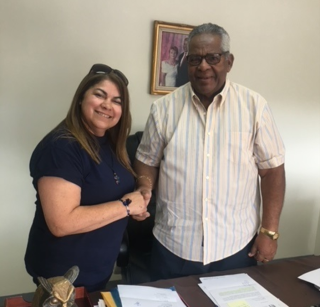Proud Hispanic Public Servant: Showcasing my Strengths
I grew up in a small, rural town in Puerto Rico, moving to the Washington D.C., Maryland, and Virginia tri-state area later in life. Adapting to life in the mainland United States was not easy, and I felt the culture shock right away. Spanish is my native language and I speak English with a Puerto Rican accent. Because of my accent, some people either didn't understand me, ignored me, or didn't take me seriously. While many people saw my Puerto Rican accent as a weakness, I saw being bilingual and bicultural as strengths. The U.S. Environmental Protection Agency offered me the opportunity to use those strengths to make a difference.
Since I was a child, my defining characteristics have been persistence and resilience. I have always been proud of my roots, and EPA has allowed me to embrace my culture and my language. I began looking for opportunities in my work where I could share indoor air quality information in Spanish. As a bilingual and bicultural employee, one of my goals has been to provide vital information clearly - in a way that is accepted and understood by our Spanish-language audience.
My Work at EPA
Twenty-three years ago when I started at EPA, there were hardly any Hispanic professionals in the agency. But now, I‘m happy to say that Spanish-speaking professionals are present in almost every area of the agency! As the Multilingual Outreach Lead for Hispanic content in the Office of Radiation and Indoor Air I serve as the liaison between EPA headquarters and EPA regional offices, as well as other key Hispanic organizations. I conduct outreach in Hispanic communities in the U.S. mainland and Puerto Rico on issues such as asthma, smoke-free homes, and radon through special projects, social media, one-day events, and radio and TV interviews.
As a member of the Indoor Air Quality Emergency Preparedness, Response and Recovery Team for ORIA, I focus on risk communication for indoor air issues related to emergencies, such as floods, wildfire smoke, and power outages. Recently, I started a series of webinars in Spanish, tailored to the Hispanic community on issues about how natural events can impact the quality of their indoor air.
I also write a quarterly Spanish newsletter that is sent to our community of Spanish stakeholders and covers the latest information for protecting indoor air quality where we live, work, learn and play. In fact, all of these resources are available from the Spanish Indoor Air Quality website – Calidad del aire interior, a sister website to its English counterpart Indoor Air Quality.
Hispanic Heritage Month

This year, we celebrate the 55th anniversary of National Hispanic Heritage Month from September 15 to October 15. The theme for this year’s celebration is “Todos Somos, Somos Uno. We Are All, We Are One.” The theme reinforces the diversity inherent within the Hispanic community, as well as the power that comes from a united community. As a Hispanic, I am proud to work in a place that encourages diversity and inclusion.
I’m also very proud to represent my roots as a Hispanic, my community, and the EPA. I invite everyone to celebrate Hispanic Heritage Month this year and encourage you to get familiar with the Hispanic culture and to look at everything from a new, more positive angle – show the world that your perceived weaknesses are your greatest strengths.

About the Author
Carmen Torrent
Program Analyst
Office of Air and Radiation
Carmen Torrent is the lead on Hispanic Outreach for the Healthy Indoor Environments in the Office of Radiation and Indoor Air, Center for Cross-Program. Carmen is a native of Puerto Rico and has a bachelor’s degree in liberal arts from the University of Puerto Rico and a Certificate on Technical Translation from the USDA Graduate School in Washington, D.C. She is a member of the Indoor Air Quality Emergency Preparedness, Response and Recovery Team and has vast experience in risk communication.
Editor’s Note: The views expressed here are intended to explain EPA policy. They do not change anyone’s rights or obligations. You may share this article. However, please do not change the title or the content, or remove EPA’s identity as the author. If you do make substantive changes, please do not attribute the edited title or content to EPA or the author.
EPA’s official web site is www.epa.gov. Some links on this page may redirect users from the EPA website to specific content on a non-EPA, third-party site. In doing so, EPA is directing you only to the specific content referenced at the time of publication, not to any other content that may appear on the same webpage or elsewhere on the third-party site, or be added at a later date.
EPA is providing this link for informational purposes only. EPA cannot attest to the accuracy of non-EPA information provided by any third-party sites or any other linked site. EPA does not endorse any non-government websites, companies, internet applications or any policies or information expressed therein.

